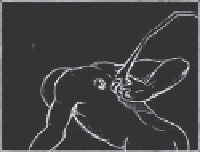Graphics Reference
In-Depth Information
SB
- Yes, sometimes for the better but not usually.
RH
- The rushes do surprise me a little, but it's usually because I fi nd that sometimes it is diffi cult to
devote 100% concentration to the job in hand; I may 'lose' it slightly and momentarily. If I notice this while
animating, though, I try to 'hide' it, or make up for it with another move with the character that is well timed.
JC
- Recently rushes have been a clearer, nicer fi lm version of what already appears on your video assist
operating system. The last 'blind' rushes I saw were on
Rockie and the Dodos
, where you'd be fi lled with
excitement and dread. Had the shot come out OK? Were the timings right? Invariably they were but we'd
all still be anxious.
The 16 mm Bolex cameras were a good size, enabling the animator to work around and
alongside the camera itself, something the big chunky 35 mm cameras made dii cult. The
cameras also had a satisfying click, so the animator knew exactly when a frame had been taken,
allowing them mentally to release all the stored information about that frame and be ready
for the next. Most animators, even when working on digital technology, still need a click. In my
early days with often two animators working on a shot, one was responsible for clicking the
camera; the other would stand back from the set and wait in a quiet Pavlovian trance, focused
on the set, until the click released them ready for the next frame. Having video technology to
show the previous shot or the whole sequence has made the burden of absolute concentration
somewhat lighter. On
The Wind in the Willows
I didn't like to stray too far from the set in the
middle of a shot for fear of losing what I was doing. Other than notes on the storyboard, there
was very little way of i nding your way back into a shot.
It must have been a nightmare for the editors, and it's hard to believe that reasonable-quality
images were possible from such a tiny frame, but many people have an af ection for 16 mm.
The Bolex cameras were user friendly and lenses could be changed in a matter of seconds.
Sometimes the cameras were in such a position on the set as to render the viewi nder
inaccessible, so the sides of the shot would be marked on set, constructing a mental acting
space. It is years since I've looked through an actual viewi nder. The monitor is the instant and
possibly lazy way now, but it gives a clear picture. What it does not give you is a muscle and
spatial memory of looking at the puppet from behind the real camera. Judging everything by
looking at the monitor gives you a very second-hand experience of what is in front of you. I
would encourage young animators to look at the puppet and to feel its movement, rather than
relying totally on the monitor. The early great animators such as Ladislas Starevitch, Willis O'Brien,
Bretislav Pojar, Emile Cohl, Jiri Trnka, Karel Zeman, Hermina Tyrova, Zenon Wasilewski, George
Pal and Ray Harryhausen managed to get great performances out of their characters without
the aid of complex technology, or any means of seeing what they were animating. Instinct,
with the occasional surface gauge, is still the best means of judging a performance. Technology
can smooth things out and correct mistakes, but it cannot save a performance that isn't there
to begin with. I'm sure those pioneering animators would have embraced any
technology that made the process easier, but they probably would have resisted
anything that distanced themselves from the performance.
Technology has changed the process, undoubtedly for the better. Time allowing,
technology can give us precise animation. There is no 'l ying by the seat of your
pants' any more. That's both good and bad. Without seeing immediately what you



Search WWH ::

Custom Search